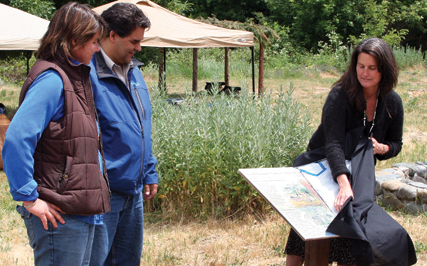Culture
Tribal interpretive signs unveiled in Ashland on June 23

ASHLAND -- On the Tribe's side, the development and installation of two interpretive signs in North Mountain Park in Ashland has been almost three years in coming.
However, for the Ashland Parks and Recreation Department, it has been in process for more than a decade.
It could not have come out better, though, for project coordinator Mike Karnosh, the Tribe's Ceded Lands coordinator.
"They have gone above and beyond to make sure all our concerns were addressed," Karnosh said. "They came up to Grand Ronde to get a firsthand look at the Tribe and meet the people. And the finished product is really, really impressive. I can't say enough about everybody's contribution. I'm overwhelmed."
This latest addition to the Tribal Historic Signs Project was officially unveiled in the park's Nature Center on Saturday, June 23, under tentative skies that held for four hours for about 50 people who attended to honor the occasion.
The Nature Center starts at the north end of the 40-acre teaching park located next to Bear Creek in Ashland. The park also includes demonstration gardens, playing fields and several acres of wildlife-friendly open space and trails.
"Ashland Parks does a lot of public education and outreach," Karnosh said, "including programs with school kids. They are really progressive because they try to teach everyone that comes through the park, and they try to make sure they get everything right. They have reached out to the Tribe in the past, so we knew we wanted to work with them on this signs project."
"Our hope is that people will see this and want to learn more and maybe realize that they can be part of the programs here," said Kari Gies, Nature Center education coordinator for Ashland Parks and Recreation. Also, she said, she looks for the project to "help us maintain a dialogue with the Tribe. Resolving the problems of the past is an ongoing process."
"Our ancestors lived in this land for thousands of years," said Tribal Council Chairwoman Cheryle A. Kennedy. "They are happy that we walk the same ground today … that the circle of life continues."
"I had the privilege to be part of the signage dedication," said Tribal Council member June Sherer. "This area, Ashland and southern Oregon, are all part of our ceded lands. It is where our Trail of Tears began.
"We are thankful to those who honored us in a heartfelt and honest way. It was uplifting to know that there are nonNatives who honor us and our ancestors with their efforts and their dedication to honoring our history."
Sherer said she was grateful to the Ashland staff and volunteers who "spent years clearing the invasive plants and restoring the area to its natural state," and because "the area was dedicated to our ancestors."
"I feel that they fully understand that this fantastic valley was sculpted by our ancestors," said Tribal Council Secretary Jack Giffen Jr., "and they're very open to telling this to the community. They've really got a community buy-in for the project, and in my eye, hey, that's the key to success. Culturally, this is a very important part of our ceded lands."
"The region is the homelands of the northern Shasta and the Takelma," said Tribal Cultural Resources Department Manager David Lewis. "The line between the two Tribes is not well known and it is thought that Ashland is the northern extremity for the Shastas. They would have camped and lived at Bear Creek, which goes directly through the park.
"The Takelma inhabited the area of Table Rocks, and Bear Creek enters the Rogue River at Lower Table Rock, across from the Tribe's Rogue River Treaty signing of 1853. The region does not have a lot of interpretation about the Tribes that originally inhabited it nor about the Table Rock Reservation. Many people in the area do not know the history of the Tribes and how this area is incredibly significant to our Tribal history. The signs project answers part of this need.
"We've learned a lot more about the area than we had known," Lewis added. "Re-familiarizing ourselves with the land is very important. When you put something like this up, (the signs) exist for 10 years or more, and so it's very important that we get it right."
He added his voice to the chorus thanking the Ashland Parks and Recreation Department for taking the time to get it right.
Julie Brown, Collections assistant in the Cultural Resources Department, also thanked Ashland staffers for "truly embracing what we were feeling in our hearts as Native Americans."
Illustrator Nancy Wylie called the project "a learning process. The work here was in the detail, and the difficulty was in how to bring all the information together into one illustration."
"I've learned so much about Native ways," said graphic designer Karin Onnka. "Everytime I'm out, I honor this land as you and your ancestors do."
Grand Ronde Royalty - Nakoosa Moreland, Iyana Holmes, Amelia Mooney, Makenzie Aaron, Amaryssa Mooney, Elizabeth Watson-Croy and Madison Aaron - performed along with singers/drummers Justin Robinson, Greg Archuleta, Miguel Adams and Jordan Mercier.
Tribal Elders in attendance included Bernadine Shriver and Dolores Parmenter. Portland office Tribal Services Representative Lisa Archuleta also attended and Tribal Public Affairs Director Siobhan Taylor coordinated the event.
The unveiling also included dance demonstrations and presentations of traditional Native crafts, including basket weaving and the process of turning stones and clays into paint-type colors.
"We're all about stewardship of the land," Gies said. "This project gives us a look at the wisdom of the past, and how well the indigenous people stewarded this land."
The Tribe also has new interpretive signs coming out at the Dallas Arboretum in July and at Salem Riverfront Park. Still others are in development.
